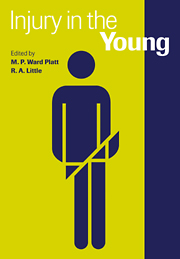Book contents
- Frontmatter
- Contents
- List of contributors
- Editors' Preface
- 1 The epidemiology of trauma involving children
- 2 Emergency room requirements for children
- 3 Child deaths in Accident and Emergency
- 4 Immediate life support
- 5 Evaluation of injury in children
- 6 Injuries of the developing brain
- 7 Wound healing in children
- 8 The lung after injury in children
- 9 Metabolic and endocrine stress responses to surgery
- 10 Head injury in children
- 11 Near drowning
- 12 The acute response to burn injury in children
- 13 Nutritional support of the severely burned child
- 14 Recovery, rehabilitation and the neuropsychological sequelae of head injury
- 15 Children's rights and child protection
- Index
14 - Recovery, rehabilitation and the neuropsychological sequelae of head injury
Published online by Cambridge University Press: 18 September 2009
- Frontmatter
- Contents
- List of contributors
- Editors' Preface
- 1 The epidemiology of trauma involving children
- 2 Emergency room requirements for children
- 3 Child deaths in Accident and Emergency
- 4 Immediate life support
- 5 Evaluation of injury in children
- 6 Injuries of the developing brain
- 7 Wound healing in children
- 8 The lung after injury in children
- 9 Metabolic and endocrine stress responses to surgery
- 10 Head injury in children
- 11 Near drowning
- 12 The acute response to burn injury in children
- 13 Nutritional support of the severely burned child
- 14 Recovery, rehabilitation and the neuropsychological sequelae of head injury
- 15 Children's rights and child protection
- Index
Summary
Introduction
Trauma in children is more likely to involve the head than in adults, and head injury is the commonest cause of acquired disability in childhood, with an estimated prevalence in the UK of at least 75 per 100,000.
In spite of this, our understanding of head injury outcome in children has been limited by a relative lack of information. In the past most studies were carried out by epidemiologists or by surgeons who did not separate children from adults, or if they did, saw childhood as ending at 14, even 12, years of age. Clinical follow-up of children was often brief, with no clearly defined hand-over to a paediatrician for longer term management. There were (and still are) considerable problems with case definition: not all the children who suffer a significant blow to the head are brought to medical attention (Rune, 1970), and the traditional measures of severity (Glasgow Coma Scale, duration of unconsciousness, duration of postraumatic amnesia) are less easily applied and interpreted in the very young child; very large data sets may mask significant findings in small subgroups (Klonoff et al., 1977); and local variations and changing practice in retrieval and acute management may be affecting outcome. These factors must be taken into account when interpreting head injury information in children, and in particular when attempting to compare results between studies.
Problems with definition of severity
Field (1976) enigmatically defined head injury as ‘trauma which carries some risk of damage to the brain’.
- Type
- Chapter
- Information
- Injury in the Young , pp. 263 - 299Publisher: Cambridge University PressPrint publication year: 1998
- 2
- Cited by



